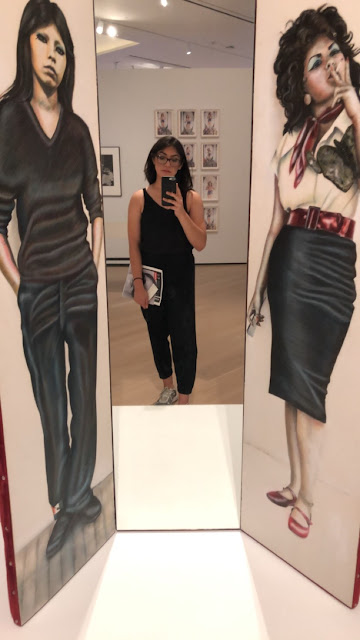I also wanted to address something we discussed in class, which was why none of the male-identified students in our class wanted to identify as feminists and very few as queer allies. Although I appreciated one student's viewpoint of being aware enough to not want to co-opt a space, I'd argue that not publicly voicing your support for a group does more to advance the opposing viewpoint than your silence does to help the one you're quietly for. Furthermore, another student mentioned a reason for not wanting to identify as feminist was because he felt a sort of cognitive dissonance between the ideals of feminism and his consumption of mainstream music and culture. This is something I've struggled with as well, but as an old professor told me, "masticalo como chicle"--that is, you can chew music and pop culture like gum, without fully ingesting it, staying aware and critical of the structures that have built such a culture. Thoughts?
This is the blog for the UCLA Chicanx Latinx Art and Artists course offered by the Cesar E. Chavez Department of Chicanx Central American Studies (CCAS M175, also Art M184 and World Arts and Cultures M128). This course provides a historical and contemporary overview of Chicanx Latinx art production with an emphasis on painting, photography, prints, murals and activist art.
Thursday, April 19, 2018
Alicia Gaspar de Alba's CARA essay
Something that struck me from the Alicia Gaspar de Alba's essay was the idea that the grouping and curation of artworks in an exhibition is just as important, if not more so, than the original intent of the artist. This was evident in the artist exhibition CARA: Chicano Art: Resistance and Affirmation, where although individually, the artworks chosen to display could be seen as strongly feminist, when grouped together as they were, portrayed Chicanas in a patriarchal light.
This notion was all the more striking because, just months previously, I had seen Judith Baca's Las Tres Marias shown at the Hammer Museum as part of their Radical Women exhibition. When I saw it displayed there, I interpreted it as challenging perceptions of what a Chicana woman should and could be. I was surprised, then, to see just how much the placement of the piece at the CARA exhibition distorted and reduced it to a placement of women between two equally male-driven views of the Chicana.
I also wanted to address something we discussed in class, which was why none of the male-identified students in our class wanted to identify as feminists and very few as queer allies. Although I appreciated one student's viewpoint of being aware enough to not want to co-opt a space, I'd argue that not publicly voicing your support for a group does more to advance the opposing viewpoint than your silence does to help the one you're quietly for. Furthermore, another student mentioned a reason for not wanting to identify as feminist was because he felt a sort of cognitive dissonance between the ideals of feminism and his consumption of mainstream music and culture. This is something I've struggled with as well, but as an old professor told me, "masticalo como chicle"--that is, you can chew music and pop culture like gum, without fully ingesting it, staying aware and critical of the structures that have built such a culture. Thoughts?
I also wanted to address something we discussed in class, which was why none of the male-identified students in our class wanted to identify as feminists and very few as queer allies. Although I appreciated one student's viewpoint of being aware enough to not want to co-opt a space, I'd argue that not publicly voicing your support for a group does more to advance the opposing viewpoint than your silence does to help the one you're quietly for. Furthermore, another student mentioned a reason for not wanting to identify as feminist was because he felt a sort of cognitive dissonance between the ideals of feminism and his consumption of mainstream music and culture. This is something I've struggled with as well, but as an old professor told me, "masticalo como chicle"--that is, you can chew music and pop culture like gum, without fully ingesting it, staying aware and critical of the structures that have built such a culture. Thoughts?
Subscribe to:
Post Comments (Atom)

No comments:
Post a Comment